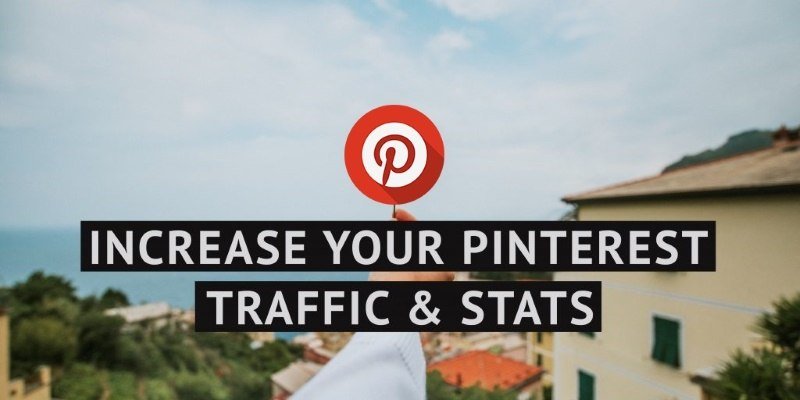
What many don’t realize is that Pinterest isn’t a true social network, but more of a visual search engine, which has its own unique algorithm. What’s possible is optimizing your images to go viral, and be discovered by buyers who are specifically searching for your product.
There are now millions of active users, that will use Pinterest as a research tool, this with a strong intent to buy. And because of this, it’s an extremely underrated platform, when it comes to driving traffic to your blog. The key becomes to make your pins as easy to discover as possible. So like any other search engine, SEO is required.
What Pinterest may not provide is immediate return-on-investment, but once the SEO is executed properly, the “pin” and traffic to your blog can become eternally viral. Traffic that’s capable of regenerating itself over time. It begins with improving your SEO Pinterest presence.
1. Optimizing Your Pinterest Profile
Before starting to pin posts which will attract motivated visitors back to your site, what needs to be tweaked is your profile, and this begins by picking the right username.
You can change it, this through the “settings” area. Pick a keyword rich profile, which describes and reflects your presence, and how you want to be discovered. What the URL does is serves as your keyword, so choose one which is clear, precise, direct, and memorable.
2. Optimizing Your Pinterest Boards
The boards should be concise and neatly organized, which emphasizes the topic title, along with the images on the boards. Pay attention to the details by using the same descriptive keywords that your visitors would use, and make sure that the image complies to the description.
From a SEO standpoint, it becomes important to know what the user is thinking, this when choosing the board title name, this by naming it exactly how it would be searched.
Although a clever funny board title is great, be more practical and concise, this to improve the boards ranking. Optimize the titles, so it can be easily understood by Pinterest, and discovered by the users.

3. Optimizing The Pins
Every pin that you post becomes a representation of your profile and brand, so it needs to be as precisely optimized as possible. It needs to be accurately described, this so the search engine can discover and understand your pins.
Make sure that the images are of the highest quality, focused, and that the picture tells the story you’re wanting to tell. Try to use tall images as often as possible, as vertical images stand out better, especially on mobile.
Pin multiple images all leading back to the same blog post, this especially for those who are looking for “How-to” instruction. Try to minimize the text on the image as much as possible. Make sure that the text is easily readable.
4. Focus On The Description
What most pinners won’t do is spend enough time on the description, thinking that the image is adequate. What this will ultimately affect, are the chances of it getting repinned.
What Pinterest prefers are precise descriptive pins, that provides a specific and thoughtful description, which helps the users easily find the image, this when they’re performing a search.
Add details which describes the image with a natural flow of consistent text, that can be easily discovered and understood by everyone.
5. Perform Exact Keyword Research
The best way of finding the right keywords to use for your pins, is by actually performing extended searches on Pinterest on your own. Find out which keywords the automatic suggestion brings, and which of the keywords are relevant to your pins.
Learn how Pinterest searching works, how and the reason why the results show up before others, and how the pins, the pinners, and the boards are organized, this to better understand how the platform behaves at the algorithm level.
Other than using desktop search, also try it on mobile, as it’s now estimated that more than 75% of Pinterest users, are on smartphones or tablets. So it becomes important to understand what the differences are in results and display, between desktop and mobile search.
6. Get A Business Account Verify Your Website
Make sure that you sign up for a Pinterest Business Account. Once you verify your blog on Pinterest, it’ll be better prioritized on the search results, this over those who don’t. What doing so increases your authority, which improves your ranking on the searches.
The best advantage of verifying your site on Pinterest, is that it allows you to access additional analytical details on your site, which helps you better understand which of your pins are the most popular, while analyzing your audience.
7. Use Of Rich Pins
Rich pins are a lot more enhanced than regular pins, which allows you to provide more detailed information about a pin. They can be used in a variety of ways, such as movies, recipes, apps, products, places, and especially articles from your blog.
Rich pins allows you to list a price of the product, an entire recipe, or an except of an article from your site. What rich pins also does is performs better, when it comes to the search rankings.
8. Pin As Consistently As Possible
What Pinterest prefers is consistency, so pin content as regularly and routinely as possible. What’s equally as important, is posting currated content, which is searching for and repinning or saving other popular pins in your niche, to your boards.
What needs to be kept in mind, is that the best pins to post on Pinterest, are “evergreen” ones, which means topics and content that stands the test of time, such as “Weight Loss.” Once your pins become relevant, they will grow and become more popular over time.

